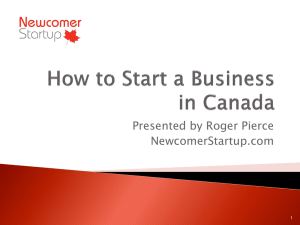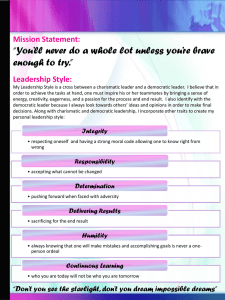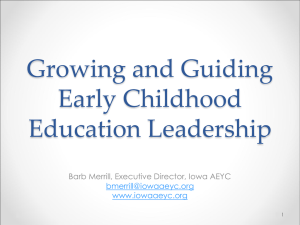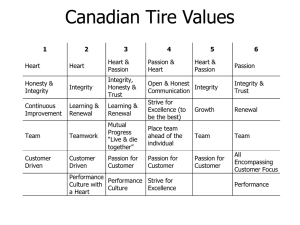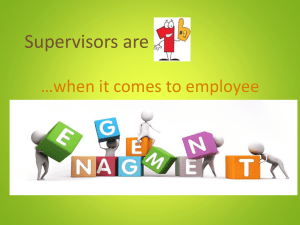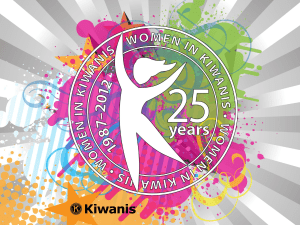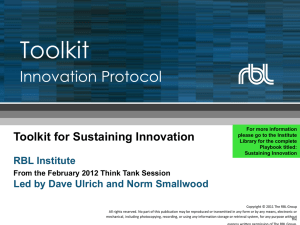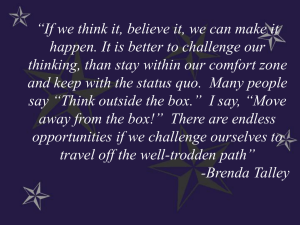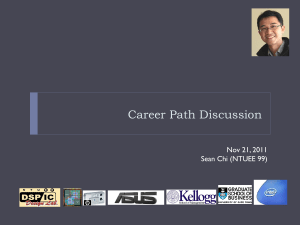Buff Your Brain
advertisement
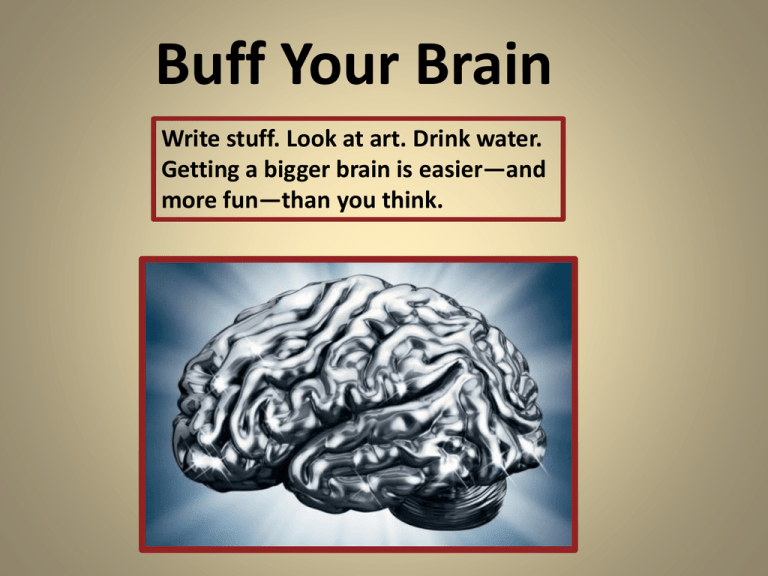
Buff Your Brain Write stuff. Look at art. Drink water. Getting a bigger brain is easier—and more fun—than you think. Brain Research: What’s New? One discovery from 2011 brain research stood out above all the others: IQ, long thought to be largely unchangeable after early childhood, can in fact be raised. And not by a mere point or two. According to a groundbreaking study published this fall in Nature, IQ can rise by a staggering 21 points over four years—or fall by 18. Twenty points is “a huge difference,” says cognitive scientist Cathy Price of University College London, who led the research. “If an individual moved from an IQ of 110 to an IQ of 130 they’d go from being ‘average’ to ‘gifted.’ And if they moved from 104 to 84 they’d go from being high average to below average.” There are 3 components that lead to changes in IQ. •Structure •Attention •Passion In their recently published study, Price and her colleagues documented how IQ changes are linked to structural changes in the brain. (This study was conducted on people ages 12 to 20.) Although most of us think of motor skills and cognitive skills as like oil and water, in fact a number of studies have found that refining your sensory-motor skills can bolster cognitive ones. No one knows exactly why, but it may be that the two brain systems are more interconnected than we realize. So if you learn to knit, or listen to classical music, or master juggling, you might be raising your IQ. The other brain element you can train in order to raise your IQ is attention. Neuroscientists have shown over and over that attention is the sine qua non of learning and thus of boosting intelligence. Only if you pay attention to an introduction at a party will you remember a person’s name. *sine qua non: an indispensable and essential action, condition, or ingredient Another way to the same end, says UCL’s Price, is “passion.” If you don’t care about what you’re reading, seeing, or hearing, it won’t be retained. The key to these kinds of gains is “intensive training;” not quite the quick brain fix we’re told can come simply from eating blueberries or drinking pomegranate juice. Instead, intelligence comes from having more neurons and synapses (connections between neurons). The creation of new neurons (neurogenesis) and synapses is what makes learning possible. •Structure •Attention •Passion So what does this mean for the classroom? •Structure •Attention •Passion There are 12 suggestions for helping students “buff their brains” at school. 1. Get Puzzled •Structure •Attention •Passion When we stimulate our brain by learning or playing we simply create new connections: the synapses grow and spread to connect neurons together. The brain can therefore be modeled through conscious (or even unconscious) processes. And…research shows word puzzles can help reduce the risk of Alzheimer’s and dementia. Answers: 1. No one, two Blame (No one to blame) 2. Right between the eyes 3. Jack in the Box 4. Down Payment 5. Left Overs 6. Bedspread Answers: 1. Keeping You Out of Trouble 2. Foreign Movie 3. A Little Rough Around the Edges 4. Too Little, Too Late 5. Double Your Money Back 6. Start of Something Big free Wuzzles available at: http://www.wuzzlesandpuzzles.com/ Magic Letter, Magic Word 1. 2. 3. The teacher announces the Magic Letter. The teacher gives clues about the Magic Words. The students record the word they think is being described. Letter A Clues: •a list of letters (alphabet) •person who writes a book (author) •people in plays or movies (actors) Letter S Clues: • 7 – 3 = 4 is an example •the total of two numbers added together •a shape with 4 equal sides Letter L Clues: •energy form the sun •shampoo, milk, orange juice •place to investigate Letter F Clues: •metaphors and similes •event that took place before the story •something that warns you of an event to come Letter F Clues: •nickname for George Washington •each country has their own unique one •products can be assembled in these What is a Hink Pink? Hink Pinks are fun rhyming word riddles. The answer to the riddle is a pair of words that rhyme with each other. For example: the clue large feline would be answered with fat cat. Hink Pinks 1. A literary thief 2. A plain sitting device 3. An uncooked animals foot 4. A prison for Moby 5. A promise to bet bigger 6. A quick explosion 7. A run for the money 8. A sack for holding Old Glory Answer Key 1. Book Crook 2. Bare Chair 3. Raw Paw 4. Whale Jail 5. Growth Oath 6. Fast Blast 7. Cash Dash 8. Flag Bag Commonyms What's a commonym? A commonym is group of words that have a common trait in the three words/items listed. For example: the words car, tree, elephant. What do they all have in common? They all have trunks! Commonyms Ball Fish Cold Commonyms Bride & Groom Boat & Trailer Horse & Buggy Commonyms #6 Doughnut Cavity Prescription Commonyms #7 Cook Toilet College Football Analogies An analogy is a comparison of certain similarities between things which are otherwise unlike. In education, teachers use analogies to introduce something new to students. They compare the new material to something the students already know and understand. An analogy can be read like this: grass : green :: sky : blue Grass is to green as sky is to blue. Analogies 1. Bird is to fly as fish is to __________. 2. Snake is to reptile as frog is to __________. 3. Parrot is to feathers as bear is to __________. 4. Zebra is to stripes as giraffe is to __________. 5. Koala is to mammal as turtle is to _________. 6. Fish is to gills as squirrel is to __________. 7. Cat is to kitten as cow is to __________. 8. Shark is to fish as dolphin is to __________. Analogies 9. Canary : yellow :: polar bear :__________. 10. Penguin : Antarctica:: as panda :__________. 11. Goose : flock :: fish: __________. 12. Ant : six legs :: spider :__________. 13. Snake : slither :: whale :__________. 14. Lizard : vertebrate :: cricket :__________. 15. Ring : sting :: bee :_________. 16. Bison : walk :: kangaroo : __________. Guess the Word Game Number your paper from 1-5. Write your guess as your teacher gives each clue. 1. It is a word from the word wall (or from today’s lesson, page ___, etc.) 2. It has _____ syllables. 3. It is used to discuss ______________ . 4. It means ___________________ . 5. It completes this sentence: _______________________________ . Guess the Word Game Number your paper from 1-5. Write your guess as your teacher gives each clue. 1. It is a word from the word wall (or from today’s lesson, page ___, etc.) 2. It has 4 syllables. 3. It is used to discuss a type of energy. 4. It means motion is happening. 5. It completes this sentence: The energy of movement is called __________ energy. Answer: mechanical 2. Get Moving •Structure •Attention •Passion Look for an activity that raises your heart rate and requires a lot of coordination, says John J. Ratey, author of Spark: The Revolutionary New Science of Exercise and the Brain. Why? Moving our muscles produces proteins that play roles in our highest thought processes. The value exercise has for the learning process in high school students includes improved academic performance, alertness, attention and motivation. Did you know you can beat stress, lift your mood, fight memory loss, sharpen your intellect, and function better than ever simply by elevating your heart rate and breaking a sweat? The evidence is incontrovertible: Aerobic exercise physically remodels our brains for peak performance. Classroom Snowball Fight Materials: Four sheets of blank paper per student (preferably recycled paper). Procedure: 1. Hand out four sheets of paper to each student. Ask them to write key information on the four sheets of paper, one item per sheet. 2. Ask all students to crumple each piece of paper into a ball. 3. Have students stand up and place them into two teams, one team at each end of the classroom. 4. Tell students they have 10 seconds to throw all the “snowballs” on their side of the classroom to the other side, but when you shout STOP everyone must stop. 5. After the STOP signal, have students pick up any four snowballs, return to their seats, and open them up to read the information. 6. Ask students to evaluate the information and be prepared to discuss it in small groups or with a partner. Question Swap 1. Supply each student with an index card or slip of paper. 2. Name a topic of study and ask students to write a question related to the topic on the piece of paper. 3. Next, students stand up and find a partner; the pair asks each other their questions. 4. The students then move to find new partners, repeating the procedure. 5. After a set time, have students return to their seats and summarize information regarding three things they were asked. Mixed Pairs: Divide the class in half. Half of the class write a word on an index card. The other half writes the definition. Shuffle the cards and hand one card to each student. The students must move around the classroom and match the word with the definition. Incorporate “walk and talk” breaks – take your class out for a walk and have students discuss what they have learned during the class period. Walking Worksheets: Tape worksheets on wall, easel and chalkboard. Students move from worksheet to worksheet and answer the different questions. •Structure •Attention •Passion 3. Get Hands-On Refining motor ability can bolster cognitive skills. make Foldables draw pictures trace images 4. Wipe the Smile Off your Face •Structure •Attention •Passion Experiments have shown that the simple act of frowning makes you more skeptical and analytic in your thinking. Select a quote from the next page as the being the most accurate statement about education. Get ready to defend your choice. 1. Education is a progressive discovery of our own ignorance. Will Durant 2. It is the mark of an educated mind to be able to entertain a thought without accepting it. Aristotle 3. Children have to be educated, but they have also to be left to educate themselves. Ernest Dimnet 4. Some people drink from the fountain of knowledge, others just gargle. Robert Anthony 5. Education's purpose is to replace an empty mind with an open one. Malcolm Forbes 5. Refine Your Thinking •Structure •Attention •Passion The brain has two distinct modes of thought, according to Daniel Kahneman, author of Thinking, Fast and Slow. System 1 is fast and automatic; System 2 is slower and more effortful. Understand these two systems, Kahneman argues, and we may be able to detect our own lazy biases and make better choices. Five percent of the people think; ten percent of the people think they think; and the other eighty-five percent would rather die than think. ― Thomas A. Edison Thinking is the hardest work there is, which is probably the reason why so few engage in it. Henry Ford Rarely do we find men who willingly engage in hard, solid thinking. There is an almost universal quest for easy answers and half-baked solutions. Nothing pains some people more than having to think. Martin Luther King, Jr. Reading is equivalent to thinking with someone else's head instead of with one's own. Arthur Schopenhauer Now THINK about your own ideas about thinking and create your own quote. 6. Hydrate •Structure •Attention •Passion Sure, every doctor and trainer tells you this, and we will too: dehydration forces the brain to work harder and may dampen its planning ability. So how much fluid does the average, healthy adult living in a temperate climate need? The Institute of Medicine determined that an adequate intake (AI) for men is roughly 3 liters (about 13 cups) of total beverages a day. The AI for women is 2.2 liters (about 9 cups) of total beverages a day. What about the advice to drink eight glasses a day? Everyone has heard the advice, "Drink eight 8-ounce glasses of water a day." That's about 1.9 liters, which isn't that different from the Institute of Medicine recommendations. Although the "8 by 8" rule isn't supported by hard evidence, it remains popular because it's easy to remember. Just keep in mind that the rule should be reframed as: "Drink at least eight 8-ounce glasses of fluid a day," because all fluids count toward the daily total. You may need to modify your total fluid intake depending on how active you are, the climate you live in, your health status, and if you're pregnant or breast-feeding. Source: Mayo Clinic, 2012 7. Look at Art •Structure •Attention •Passion Not only does it make you look smart, but viewing art has been shown to reduce stress, letting you focus on the things that really matter. Ten Lessons the Arts Teach The arts teach children to make good judgments about qualitative relationships. Unlike the curriculum in which correct answers and rules prevail, in the arts, it is judgment rather than rules that prevail. The arts teach children that problems can have more than one solution and that questions can have more than one answer. The arts celebrate multiple perspectives. One large lessons is that there are many ways to see and interpret the world. The arts teach children complex forms of problem solving. Learning in the arts requires the ability and a willingness to discover the possibilities of the work as it unfolds. The arts make vivid the fact that neither words nor numbers exhaust what we can know. The limits of our language do not define the limits of our cognition. Ten Lessons the Arts Teach, con’t The arts teach students that small differences can have large effects. The arts work in subtleties. The arts teach students to think through and within a material. Art forms employ some means in which images become real. The arts help children learn to say what cannot be said. When children asked what a work of art helps them feel, they must reach to find the words that will do the job. The arts enable us to have experience we can have from no other source and through such experience to discover the range and variety of what we are capable of feeling. The arts’ position in the school curriculum symbolizes to the young what adults believe is important. SOURCE: Eisner, E. (2002). The Arts and the Creation of Mind, In Chapter 4, What the Arts Teach and How It Shows. (pp. 70-92). Yale University Press. Available from NAEA Publications. Copyright © Starry Night 8. Write by Hand •Structure •Attention •Passion Remember what that feels like? Brain scans show that handwriting engages more sections of the brain than typing. Bonus brain boost: it’s easier to remember something once you’ve written it down on paper. Typing is certainly a lot more efficient, but discarding handwriting entirely might not be such a great idea. Picking up a pencil and a pad of paper to write out your ideas could aid your thought process and learning ability. If not just for the level of focus you get from having nothing but a pad of paper in front of you, you might benefit from the actual act of writing by hand. The Wall Street Journal takes a look at how this is an important developmental skill for children, but how it also applies to adults looking to keep their minds active. The idea is that the actual act of writing out the letter takes a little more work in your brain than just typing the letters on a keyboard, and that extra work keeps your mind sharp. How Handwriting Trains the Brain [The Wall Street Journal via The 99 Percent] 9. Set Some Limits •Structure •Attention •Passion Time-management methods can make you more productive using nothing more than a kitchen timer. Use it to help work in 25-minute blocks, taking a short break after each; the frequent rests aid mental agility. 10. Delay Gratification Studies have found that children who were able to resist a marshmallow placed in front of them turned out, years later, to have higher SAT scores than students who snatched it up. The more successful children didn’t necessarily have a natural gift for patience; they controlled their attention by focusing on something else. •Structure •Attention •Passion In our society, we are bombarded with the temptation of short-term gains. Fastfood, lottery tickets, shopping malls, bars, Las Vegas, and quick-fixes to problems. Benefits of Delaying Gratification Improve your academic and job performance. Gains usually continue throughout life, creating more satisfaction and success in their careers . Enhance your relationships. As our patience increases, we become less vulnerable to anger and its tendency to drive others away from us. We learn to look at the big picture and take other’s feelings into account. Become more physically fit. Studies also show that those less practiced at delayed gratification, or “low delayers,” tend to have higher body fat. If you appreciate the long term benefits of nutritious food and regular exercise, you’re less likely to overindulge in junk food. Lower your risk of substance abuse. Drug addiction can be one of the most painful consequences of seeking immediate pleasure. Even legal activities like shopping or watching TV can be destructive if we take them to extremes and allow them to crowd out more meaningful endeavors. Enjoy more contentment. Self control enables us to set goals and focus our energies on reaching them. We can make better choices, accomplish more and handle setbacks better. Techniques for Delaying Gratification Divert your attention. Just turning your attention away from temptation will instantly make you a little happier and better behaved. The more you learn to control your thinking, the wiser you will become. Take a pause. Pausing for a second can help you avoid reflexive responses that run against your best interests. Decide if important to cut class or make an unkind remark . Seek out good role models. Child psychologists find peer modeling to be a highly effective tool for character education. Whatever your age, pick up some valuable lessons by observing someone whose patience you admire. Reinforce your new habits. Self control grows stronger the more we practice. Look for daily opportunities to delay gratification, whether it’s choosing a more nutritious breakfast, better study habits, or changing a negative behavior. 11. Become an Expert •Structure •Attention •Passion Master one task you really enjoy and your brain will perform more efficiently when you do it. Chess whizzes, for example, recognize patterns more quickly than amateurs. Expertise is not innate—practice, as the old saw goes, does make perfect. There’s no better way to become an expert than to teach others. How can you put students in the teaching/expert role in the classroom? How to Become an Expert Published on September 3, 2011 by Carl Beuke, Ph.D. 12. Write Reviews Anyone can be a critic on the Internet—and you should too. When you like or hate something, review it on Amazon, Yelp, Twitter, whatever. Writing out your opinion will help you to better understand your own thinking. •Structure •Attention •Passion Review Guidelines • The review should be relatively short with opinions delivered in a clear, concise manner. • The factual material must be correct. Check all facts pertaining to the content. • The review should be firm and assertive, not wishywashy. A reviewer must have a strong opinion. • The reviewer is entitled to whatever opinion he or she has of the work be it positive or negative, but the opinion must be substantiated with details and examples. • The reviewer should establish a voice, tone, and personal style that make the review interesting. Consider this scenario: •A teacher has taught for more than two decades. •He considers himself to be a very good teacher. •He knows his content. •He has organized his lessons and worksheets. •His mode of instruction : lecture. •His mode of has ONE cognitive strategy: worksheet. •His has ONE mode of assessment: written test. •He believes that if he says it, students will know it. Think about some of the strategies we just discussed, and consider adding at least one to your classroom during the first week of school. What strategy do you think you might use? Sharon Begley is the science columnist and science editor of Newsweek. She is the coauthor of the 2002 book The Mind and the Brain and the author of the 2007 book Train Your Mind, Change Your Brain. This article was the main resource for this information. Now… one quick message about your heart:
